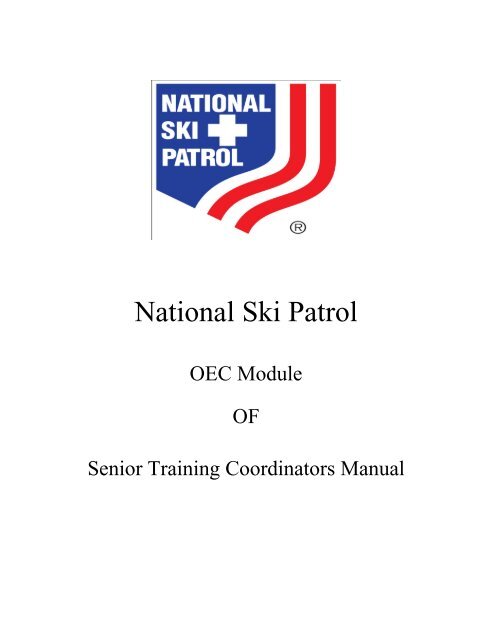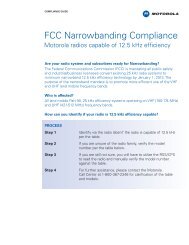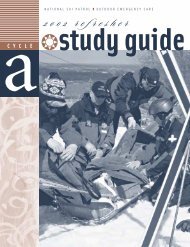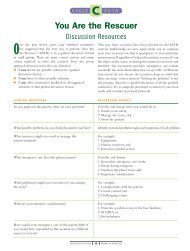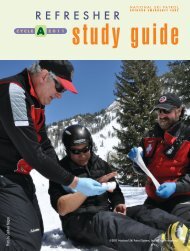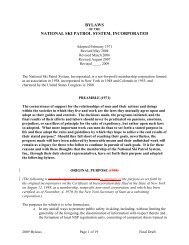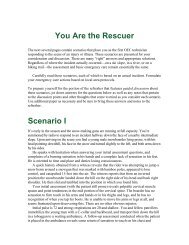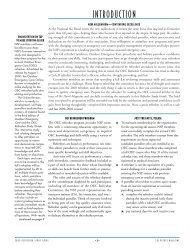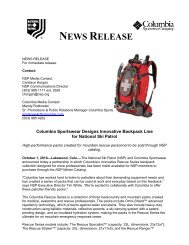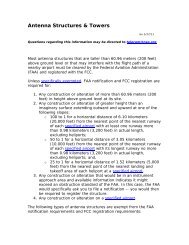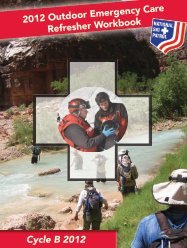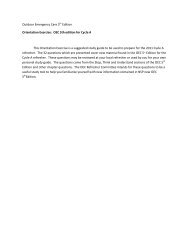OEC Module for Senior February 2013 - National Ski Patrol
OEC Module for Senior February 2013 - National Ski Patrol
OEC Module for Senior February 2013 - National Ski Patrol
You also want an ePaper? Increase the reach of your titles
YUMPU automatically turns print PDFs into web optimized ePapers that Google loves.
<strong>National</strong> <strong>Ski</strong> <strong>Patrol</strong><br />
<strong>OEC</strong> <strong>Module</strong><br />
OF<br />
<strong>Senior</strong> Training Coordinators Manual
This page is left intentionally blank.<br />
Page 2 of 43
MISSION STATEMENT……….….……………………………………………………………5<br />
INTRODUCTION………………….…………………………………………………………….5<br />
GOAL……………………………………………………………………………………………..5<br />
PROGRAM OVERVIEW………………………….……………………………………………5<br />
Organization……………………………………...………………………………………6<br />
References…………………………………………...…………………………………....6<br />
Required Forms……………………………………...…………………………………..6<br />
Responsibilities………………………………………..………………………………….7<br />
PROCESS…………...………………………………………….………………………………...7<br />
Organizing The Training Program…………………………………………………...…7<br />
TRAIN SESSIONS………………………………………….……………………………………9<br />
CANDIDATE PREPARATION AND TRAINING………………………….…...…………..10<br />
EVALUATION………………………………………………………………………………….12<br />
General Requirements……………………………………………………………….....12<br />
Candidate Team Format………………………………………………………………..13<br />
Location, Setting and Equipment……………………………………………...………13<br />
Selecting Patients and Bystanders………………………………………...…………...14<br />
Selecting Assigned Evaluators………………………………………………………..15<br />
Selecting Station Evaluators…………………………………………………...………15<br />
Station Managers……………………………………………………………………….16<br />
Selecting, Using and Setting Up Practical Scenarios………………………………....16<br />
Evaluation Scenarios and Rounds……………………………………………...……...17<br />
Evaluation and Using the Scorecard…………………………………………...……...18<br />
Page 3 of 43
Program Evaluation…………………………………………………………………….20<br />
Arbitration and Problem Resolution……………………………………………...…….19<br />
Final EvaluationCompletion……………………………………………...…….. 21<br />
REQUIRED PAPERWORK………………………………………………….………….22<br />
Candidate Paperwork……………………………………………………………..……..22<br />
Evaluation Paperwork……………………………………………………..…….. 22<br />
APPENDIX A – NATIONAL <strong>OEC</strong> MODULE OF THE SENIOR PROGRAM<br />
PROGRAMS………………..………………..………………………………………….. 25<br />
APPENDIX B – <strong>OEC</strong> MODULE OF THE SENIOR PROGRAM EVALUATION<br />
APPLICATION………..……..…….….......................................................................................26<br />
APPENDIX C – <strong>OEC</strong> MODULE OF THE SENIOR PROGRAM CANDIDATE<br />
FORMS…………………………………..….……......................................................................27<br />
<strong>Senior</strong> Candidate Application…………………………………………………………………..27<br />
<strong>OEC</strong> MODULE OF THE SENIOR PROGRAM Candidate<br />
Checklist………………………………………………………………………………………….28<br />
Completion Log <strong>for</strong> <strong>OEC</strong> Basic <strong>Ski</strong>lls Per<strong>for</strong>mance Check-off..………………….…..29<br />
Scenario Scoring Matrix………………………………………………….……………..30<br />
Written Scenario Worksheet……………………………………………..……………..32<br />
APPENDIX D – EVALUATION SET UP AND MATRICES…………………..…………….34<br />
APPENDIX E – <strong>OEC</strong> MODULE OF THE SENIOR PROGRAM PROGRAM SCENARIO<br />
EVALUATION CARD…………………....................................................................................37<br />
APPENDIX F – PROGRAM EVALUATION FORM………………….………………..…….38<br />
APPENDIX G – COMPLETION FORMS REQUIRED……………..……………………….40<br />
<strong>OEC</strong> MODULE OF THE SENIOR PROGRAM Final Evaluation<br />
Record…………………………………………………………………………………………….41<br />
<strong>OEC</strong> MODULE OF THE SENIOR PROGRAM Final Evaluation<br />
Form………………………………………………………………………………………………42<br />
Division QA Form………………………………………………………………………………..43<br />
Page 4 of 43
Page 5 of 43
MISSION STATEMENT<br />
The <strong>Senior</strong> Outdoor Emergency Care (<strong>OEC</strong> MODULE OF THE SENIOR PROGRAM) component is a<br />
national education program that encourages members to participate in field relevant exercises to help<br />
them develop skills in decision making, problem management and leadership as it relates to the treatment<br />
of patients.<br />
In addition the practical exercises that are conducted enhance the ability of the patrollers to handle<br />
serious patients in an austere environment.<br />
INTRODUCTION<br />
PURPOSE:<br />
This guide has been prepared to assist Region <strong>OEC</strong> Administrators (ROA) and <strong>Senior</strong> Training<br />
Coordinators (STC) in conducting <strong>Senior</strong> Outdoor Emergency Care (<strong>OEC</strong> MODULE OF THE SENIOR<br />
PROGRAM) Programs within their respective regions. These positions are defined under the<br />
Responsibilities section<br />
GOAL:<br />
The <strong>OEC</strong> MODULE OF THE SENIOR PROGRAM Program has been established to expand and<br />
improve the knowledge and skills of NSP members relating to handling complex situations involving<br />
decision making, problem management and leadership. This program is designed <strong>for</strong> alpine, nordic and<br />
auxiliary patrollers (variations in requirements are noted). The program also prepares patrollers <strong>for</strong><br />
leadership roles within the NSP.<br />
PROGRAM OVERVIEW<br />
1. The <strong>OEC</strong> MODULE OF THE SENIOR PROGRAM Program is a national training program; the<br />
<strong>National</strong> Board retains control<br />
over <strong>Senior</strong> Program policies and guidelines. The established program outlines and policies must be<br />
followed without local modification. The program maintains consistency and quality assurance across all<br />
Divisions. The goal of the program is to maintain the same consistency and quality <strong>for</strong> all <strong>OEC</strong><br />
MODULE OF THE SENIOR PROGRAM candidates across the country. The <strong>OEC</strong> MODULE OF THE<br />
SENIOR PROGRAM Program is supervised by each Division’s <strong>OEC</strong> Supervisor. (See Appendix A)<br />
Page 6 of 43
2. The <strong>OEC</strong> MODULE OF THE SENIOR PROGRAM Program is a three (3) part program;<br />
Commitment, Training, and Evaluation.<br />
This program represents a significant commitment on the part of all Candidates and <strong>OEC</strong><br />
Trainer/Evaluators in the senior program.<br />
<br />
<br />
<br />
The Commitment: <strong>OEC</strong> MODULE OF THE SENIOR PROGRAM Candidates are required to<br />
obtain a copy of the current edition of the <strong>Ski</strong> <strong>Patrol</strong>ler’s Manual, the current Outdoor Emergency<br />
Care manual, and make a serious commitment to the program in the fall, or at the latest early in<br />
the ski season. By the end of December, or earlier if required by the region, candidate<br />
applications should be approved by their respective <strong>Patrol</strong> Director/NSP Rep. and should be<br />
<strong>for</strong>warded to their Regional STC.<br />
The Training: <strong>OEC</strong> MODULE OF THE SENIOR PROGRAM training is designed to be<br />
conducted at the region, section or patrol level under at the direction of the <strong>Senior</strong> Training<br />
Coordinator and conducted by the <strong>OEC</strong> MODULE OF THE SENIOR PROGRAM T/E.<br />
The Evaluation: <strong>OEC</strong> MODULE OF THE SENIOR PROGRAM Candidates must attend and<br />
satisfactorily complete a <strong>for</strong>mal evaluation, which serves as the final evaluation and validation<br />
step in the <strong>OEC</strong> MODULE OF THE SENIOR PROGRAM Program.<br />
ORGANIZATION:<br />
For any issues involving the <strong>OEC</strong> MODULE OF THE SENIOR PROGRAM Program, the STC<br />
interfaces with their Region <strong>OEC</strong> Administrator (ROA) or designee, who then reports to the Division<br />
<strong>OEC</strong> Supervisor.<br />
REFERENCES:<br />
Outdoor Emergency Care Manual, Fifth Edition, Brady/Pearson<br />
<strong>Ski</strong> <strong>Patrol</strong>lers Manual<br />
<strong>National</strong> <strong>Ski</strong> <strong>Patrol</strong> Policy and Procedures<br />
Instructors Manual <strong>for</strong> Outdoor Emergency Care<br />
REQUIRED FORMS:<br />
Application to Conduct a <strong>OEC</strong> MODULE OF THE SENIOR PROGRAM Evaluation (Appendix B)<br />
<strong>OEC</strong> MODULE OF THE SENIOR PROGRAM Candidate Forms (Appendix C)<br />
Program Evaluation Form (Appendix F)<br />
<strong>OEC</strong> MODULE OF THE SENIOR PROGRAM Final Evaluation Record (Appendix G)<br />
<strong>OEC</strong> MODULE OF THE SENIOR PROGRAM Final Evaluation Form (Appendix G)<br />
Division QA Form (Appendix G)<br />
Page 7 of 43
RESPONSIBILITIES:<br />
For purposes of this document, the positions listed below are job responsibilities and can be assumed by<br />
one or more individuals or combined as determined by the needs of the Division.<br />
<strong>Senior</strong> <strong>OEC</strong> Training Coordinator (STC): The STC works under the guidance of the region’s ROA<br />
and the Division <strong>OEC</strong> Supervisor or designee assigned to that area. This individual is appointed by the<br />
Division <strong>OEC</strong> Supervisor after consulting with the regions RD and ROA. It is the responsibility of the<br />
STC to manage the program <strong>for</strong> the region. This includes planning and scheduling the training sessions<br />
and final evaluations, coordination with the region staff as well as the Division <strong>OEC</strong><br />
Supervisor/Representative, executing the program, completing all documentation requirements and<br />
ensuring the program meets the requirements of the <strong>National</strong> standards.<br />
Trainer/Evaluator: T/Es serve dual roles; during training sessions their role is one as a Trainer <strong>for</strong> the<br />
candidates where they review the scenario results with the candidates and provide constructive feedback<br />
on execution issues. When per<strong>for</strong>ming the <strong>for</strong>mal evaluation, the Trainers become Evaluators and<br />
evaluate the capability of the candidate to meet the standards defined by the <strong>National</strong> <strong>Ski</strong> <strong>Patrol</strong> to meet<br />
<strong>Senior</strong> <strong>OEC</strong> status.<br />
Division <strong>OEC</strong> Supervisor/Designee: The representative provides evaluation quality control by<br />
reviewing the evaluation plan created by the STC prior to the evaluation and attending the evaluation to<br />
ensure that it meets the standards of the Division and the <strong>National</strong> <strong>Ski</strong> <strong>Patrol</strong>. This individual is also a<br />
key participant along with the STC in resolving pass/fail issues.<br />
<strong>Senior</strong> <strong>OEC</strong> Candidates: The candidates must meet the requirements stated in the <strong>Ski</strong> <strong>Patrol</strong>lers<br />
Manual. In order to be an effective candidate they must have strong medical skills; the stronger the skills<br />
the more likely that they will be successful in the program. Although first aid isn’t the final<br />
determination that the candidate is senior material, it is the application of those skills as they apply to the<br />
scenario that enables the decision-making, leadership and the problem management skills necessary to<br />
complete the evaluation successfully.<br />
I. PROCESS<br />
ROAs and STCs, with the cooperation of the region’s <strong>Patrol</strong> Directors/NSP Representatives need to<br />
establish a training plan and final evaluation schedule <strong>for</strong> the senior program early in the season.<br />
Regional training plans need to provide <strong>for</strong> patrol as well as other centralized training. Training<br />
schedules must be established and made known early so as to be accessible and convenient <strong>for</strong><br />
interested patrollers.<br />
A. Organizing the Training Program<br />
1. The STC must complete an Application to Conduct a <strong>OEC</strong> MODULE OF THE SENIOR<br />
PROGRAM Program Evaluation and return it to the appropriate Division <strong>OEC</strong> Supervisor or<br />
designee at least eight<br />
weeks prior to the final<br />
Page 8 of 43
evaluation, or no later than January 15 th of each year. A reproducible copy of the Application to<br />
Conduct a <strong>OEC</strong> MODULE OF THE SENIOR PROGRAM Evaluation is found in Appendix B.<br />
2. Upon approval of the application by the Division <strong>OEC</strong> Supervisor, the STC must electronically<br />
register the <strong>OEC</strong> MODULE OF THE SENIOR PROGRAM events through the national office.<br />
3. The training schedule should be developed early and coordinated so as to minimize conflicts<br />
with other region or division activities. It should be published prior to the Fall Refreshers.<br />
This will assist candidates in making a commitment to the program and will allow the staffing<br />
process to begin.<br />
4. Candidate Training schedules should include and not be limited to the following. Specific dates,<br />
times and locations of all training and evaluation events. following<br />
Candidate orientation program:<br />
o Should outline the program requirements and expectations,<br />
o Review the training schedule and hand out materials such as manuals and<br />
candidate checklists.<br />
<strong>Ski</strong>ll per<strong>for</strong>mance opportunities:<br />
o Provisions <strong>for</strong> candidates to demonstrate the <strong>OEC</strong> <strong>Ski</strong>ll level necessary <strong>for</strong><br />
successful <strong>OEC</strong> MODULE OF THE SENIOR PROGRAM completion.<br />
o Obtain the necessary <strong>OEC</strong> skill per<strong>for</strong>mance verifications from an <strong>OEC</strong> Instructor.<br />
• All practice sessions should be under the tutorship of a <strong>OEC</strong> MODULE<br />
OF THE SENIOR PROGRAM T/E.<br />
• Focus on developing the skills of decision making, problem management<br />
and leadership. Trainers and candidates are encouraged to take this<br />
practice beyond the minimum program requirements, and to make up their<br />
own scenarios and practice these skills in as many different patrol settings<br />
as possible. Scenario practice is the cornerstone of the <strong>OEC</strong> MODULE<br />
OF THE SENIOR PROGRAM Program training.<br />
o Training also provide valuable experiences <strong>for</strong> existing and new <strong>OEC</strong> MODULE<br />
OF THE SENIOR PROGRAM T/E. Each Division <strong>OEC</strong> Supervisor is responsible<br />
<strong>for</strong> training and calibration of <strong>OEC</strong> MODULE OF THE SENIOR PROGRAM T/E<br />
<strong>for</strong> program quality assurance purposes.<br />
<br />
Scheduling of the final evaluation:<br />
o Early publication of the final evaluation schedule will relieve the uncertainty and<br />
stress normally encountered by the candidate. Specific attention should be<br />
devoted to explaining the process during the initial candidate orientation.<br />
B. Training Sessions<br />
The training sessions may be held at any time or location. The minimum requirements of the<br />
program state that each candidate is required to lead 4-practice scenarios prior to the final<br />
evaluation.<br />
<br />
Training sessions are scheduled to meet the needs of the majority of trainees. The trainee<br />
Page 9 of 43
must successfully lead 4 of the 7 Scenarios found in Appendix G of the <strong>Ski</strong> <strong>Patrol</strong>lers Manual<br />
current edition to meet the requirements of the evaluation. The <strong>for</strong>mats of the training<br />
sessions should be set up to be similar to the final evaluation i.e. small teams assigned to<br />
stations overseen by the T/E. After the completion of the scenario, the TE and the candidates<br />
review the actions taken at each station and discuss appropriate management techniques as<br />
well as possible methods <strong>for</strong> improvements.<br />
The first training session should include an introduction to the <strong>OEC</strong> MODULE OF THE<br />
SENIOR PROGRAM Program. This introduction will provide the trainee with program<br />
objectives and per<strong>for</strong>mance expectations. A review of required documentation as well as<br />
presentation of clear timelines <strong>for</strong> completing required components is essential <strong>for</strong> candidate<br />
success. Following the introduction, attention should be drawn to the requirement of the<br />
breakdown of 2 written scenarios. This breakdown will help the candidates identify problem<br />
management, decision making and leadership skills necessary <strong>for</strong> successful completion of<br />
the program. Regions may also elect to conduct an <strong>OEC</strong> Technician skill sign off session<br />
during this time frame.<br />
The following training session should be set up with stations of different level 5/6 scenarios.<br />
Teams should be chosen arbitrarily <strong>for</strong> each training session. Moulage should be used as<br />
much as practical at each station during the training session. Moulage provides the candidates<br />
with a reasonable presentation of the injury being portrayed.<br />
An additional objective of each training session is to have different T/Es present. It allows the<br />
trainee to become familiar with the T/E and there<strong>for</strong>e less intimidated by them at the final<br />
evaluation. The T/Es are also given an opportunity to sharpen their evaluation skills in<br />
preparation <strong>for</strong> the final evaluation.<br />
The Training Setting<br />
<br />
<br />
Training may be conducted at a non-ski area facility with suitable terrain and should be on<br />
snow. Terrain, equipment and the environment must be as realistic as possible; otherwise<br />
candidates are unfairly trained. The general sequence of events is to have the candidate<br />
dispatched, arrive at the situation, evaluate it, call <strong>for</strong> help and equipment, have a sled and<br />
equipment arrive, treat the illness or injury and have the patient loaded in the sled .<br />
Throughout the entire training process, it is recommended that all trainers develop the<br />
practice of realism. Practical problems and obstacles must be as realistic as possible (i.e.<br />
don’t call a piece of bamboo a tree), held in a realistic location and use simple moulage.<br />
Insist on real time lines <strong>for</strong> the arrival of help or equipment in order to obtain optimum<br />
training results.<br />
Staffing the Training Program<br />
<br />
<br />
<strong>OEC</strong> MODULE OF THE SENIOR PROGRAM training may be provided or coordinated<br />
under the direction of <strong>Senior</strong> T/Es. Other experienced patrol personnel or professionals<br />
may be used in the training process, as long as they follow the approved training<br />
curriculum, which is in accordance with the Outdoor Emergency Care criteria.<br />
If a region’s training program is to be divided between one or more patrols, each such<br />
training location must have an lead trainer evaluator approved by the STC to oversee each<br />
Page 10 of 43
training site. The STC maintain ultimate responsibility <strong>for</strong> the quality of the training<br />
program.<br />
<br />
Special care should be exercised in selecting patients of the on-snow scenarios. The<br />
patients should be experienced patrollers or <strong>OEC</strong> instructors whenever possible.<br />
C. Candidate Preparation and Training<br />
Training Philosophy<br />
<br />
Training is the key to the success of the <strong>OEC</strong> MODULE OF THE SENIOR<br />
PROGRAM. ROAs and STCs must play an active role in assuring that an<br />
organized, quality training program is offered at the region, section or patrol level.<br />
While it is recognized that training <strong>for</strong>mats may vary from region to region, a preestablished<br />
training schedule is a necessity. <strong>OEC</strong> MODULE OF THE SENIOR<br />
PROGRAM Candidates are expected to participate in the training process,<br />
satisfactorily complete all program requirements and attend and satisfactorily<br />
complete a Divisional final evaluation.<br />
Anxiety and Competency<br />
<br />
There is a certain amount of anxiety and stress associated with any evaluation or<br />
emergency situation. The training program is <strong>for</strong> candidates in developing an<br />
ability to manage anxiety and stress in the emergency situation. Anxiety should not<br />
be an excuse <strong>for</strong> inadequate per<strong>for</strong>mance.<br />
The <strong>OEC</strong> MODULE OF THE SENIOR PROGRAM candidate should have<br />
demonstrated skills through evaluated scenarios by a SR T/E prior to the final<br />
evaluation.<br />
<br />
Competency, the successful demonstration of all skill sets is expected on final<br />
evaluation day. Candidates should be made aware of these expectations in advance<br />
of their commitment to the program. A clear understanding of the program<br />
expectations and the evaluation environment is a must. The program addresses<br />
these needs.<br />
Registering Prospective Candidates<br />
<br />
<br />
Schedules and program in<strong>for</strong>mation should be made available to all patrols, <strong>Patrol</strong><br />
Directors/NSP Reps, and prospective candidates at region and patrol meetings. All<br />
training sessions must be posted as on region and/or division calendars. In<br />
addition, the <strong>OEC</strong> MODULE OF THE SENIOR PROGRAM program must be<br />
registered electronically with national.<br />
Candidate applications must be completed, signed by the candidate’s <strong>Patrol</strong><br />
Director/NSP Rep., and <strong>for</strong>warded to the respective Region STC prior to any<br />
candidate making a commitment to the <strong>OEC</strong> MODULE OF THE SENIOR<br />
PROGRAM program <strong>for</strong> that season. All application must be received prior to the<br />
Page 11 of 43
Eligibility Requirements<br />
start of the <strong>OEC</strong> MODULE OF THE SENIOR PROGRAM Program. The<br />
applications should be maintained by the <strong>Senior</strong> Training Coordinator.<br />
<br />
<br />
<br />
NSP members may enroll in the <strong>OEC</strong> MODULE OF THE SENIOR PROGRAM<br />
training program at any time after achieving patroller status and obtaining their<br />
<strong>Patrol</strong> Director’s/NSP Rep.’s recommendation.<br />
A minimum of one ski season of experience at patroller level is required be<strong>for</strong>e<br />
they are eligible <strong>for</strong> the final <strong>OEC</strong> MODULE OF THE SENIOR PROGRAM<br />
evaluation.<br />
Questions regarding candidate eligibility should be directed to the ROA, STC, or<br />
Division Supervisor <strong>for</strong> that area.<br />
Application Form<br />
<br />
See Appendix B <strong>for</strong> a reproducible copy of the <strong>Senior</strong> Candidate Application.<br />
<strong>OEC</strong> MODULE OF THE SENIOR PROGRAM Program Materials<br />
<br />
<br />
Each candidate will receive the program as written in the latest edition of the <strong>Ski</strong><br />
<strong>Patrol</strong>ler’s Manual.<br />
See Appendix C <strong>for</strong> a reproducible copy of the <strong>OEC</strong> MODULE OF THE<br />
SENIOR PROGRAM Candidate Checklist, detailing the steps needed to<br />
satisfactorily complete the <strong>OEC</strong> MODULE OF THE SENIOR PROGRAM<br />
training program.<br />
D. Evaluation<br />
General Requirements<br />
An application to conduct a SR<strong>OEC</strong> Final Evaluation (see Appendix B) must be completed<br />
and <strong>for</strong>warded to the Division Supervisor no less than eight (8) weeks prior to the<br />
scheduled final evaluation date and not later than January 15th of each ski season.<br />
STCs should ensure that the application is complete. Special attention should be given to the<br />
candidate team <strong>for</strong>mat, training schedule, dates, times and location of the final<br />
evaluation. Incomplete applications may not be accepted by the Division Supervisor.<br />
The Division will establish a minimum number of candidates needed to conduct a final<br />
evaluation. When the number of candidates exceeds the limits set by the STC, a<br />
second evaluation can be established, as long as adequately staffed; or, candidates<br />
can be urged to attend an evaluation in another region. Final approval will rest with<br />
the involved region's STC and their respective Division supervisors.<br />
Page 12 of 43
STCs will be notified by the Division Supervisor at least two weeks in advance of the<br />
scheduled date of the identity of the Division <strong>OEC</strong> Representative assigned to the<br />
Final Evaluation. The Division <strong>OEC</strong> Representative will contact the evaluation<br />
coordinator in advance of the evaluation date to discuss the evaluation schedule,<br />
staffing and logistics.<br />
ROAs and STCs are encouraged to contact neighboring regions to invite and encourage<br />
participation by evaluators from these regions. This experience broadens the<br />
evaluation and learning experience of all involved.<br />
STCs must verify the following prior to allowing any candidate to participate in the<br />
Final Evaluation (preferably prior to the day of the Final Evaluation):<br />
<br />
That a Candidate Application signed by the appropriate <strong>Patrol</strong> Director/NSP Rep. is on<br />
file, and that the candidate has successfully completed a training program at the<br />
patrol, section and/or region level.<br />
That the candidate has satisfactorily completed and submitted the answers two (2)<br />
written scenario examples provided in the <strong>Ski</strong> <strong>Patrol</strong>ler's Manual.<br />
<br />
That the candidate has submitted a completed senior level written scenario.<br />
That the candidate has submitted a Completion Log <strong>for</strong> <strong>OEC</strong> Basic <strong>Ski</strong>lls Per<strong>for</strong>mance.<br />
A Completion Log is verification that all <strong>OEC</strong> skills and the four (4) on-snow<br />
practical scenarios have been satisfactorily completed. <strong>OEC</strong> Instructors may sign off<br />
on the <strong>OEC</strong> Basic <strong>Ski</strong>lls. A SR<strong>OEC</strong> T/E must sign off on the practical scenarios. (A<br />
reproducible copy of the log is found in Appendix C).<br />
Candidates must be provided advance and reasonable notice of the time and location of<br />
the Final Evaluation. The notice should include at a minimum the date, time and<br />
specific location of the Final Evaluation, the expected arrival time and check-in<br />
location, and a reminder to bring all normal ski and patrolling equipment and<br />
documentation of training program completion<br />
Station Evaluators<br />
Only Division approved SR<strong>OEC</strong> T/Es may be used as station evaluators during the final<br />
evaluation.<br />
Each station must have at least two T/Es, and each team/candidate must have an<br />
Assigned Evaluator. This Assigned Evaluator is assigned to each candidate or team<br />
and will be present at each evaluation done by their assigned candidate or team.<br />
Individuals chosen to act as the Assigned Evaluator shall possess the following<br />
qualities:<br />
Good Communication skills<br />
Have demonstrated good interpersonal skills<br />
An ability to evaluate objectively<br />
Page 13 of 43
A desire to help the candidate<br />
A positive attitude, patience and understanding, sensitivity, keen observation skills<br />
Strong <strong>OEC</strong> skills<br />
An ability to measure effectiveness based on results, not singular methods<br />
Scenario Selection<br />
Care must be taken in scheduling Evaluators to ensure that there are no conflicts of<br />
interest which may result from candidate rotations through the evaluation (ie:<br />
husband/wife, parent/child, patrol director/patroller, ROA).<br />
Evaluators must be carefully paired so as to achieve the best possible balance in<br />
evaluating capability.<br />
No more than one newly appointed Evaluator should be assigned to the same station.<br />
DO NOT schedule an individual as an Evaluator who cannot stay <strong>for</strong> the entire day,<br />
including candidate debriefing.<br />
Only Level 5/6 scenarios from the <strong>National</strong> <strong>OEC</strong> Test Bank are allowed <strong>for</strong> Final<br />
Evaluations. Select only those practical problems that can be realistically staged in the<br />
area where the evaluation is being conducted.<br />
Different scenarios will be selected <strong>for</strong> each of 3 rounds: a Warm Up round, a 1st “Final”<br />
round, and a 2nd “Final” round. The “Final” scenarios must include a multiple injury<br />
scenario and a multiple patient scenario. In addition, one “Final” scenario must include the<br />
use of a backboard. Depending on the team <strong>for</strong>mat used, multiple scenarios similar in<br />
structure and difficulty may be needed <strong>for</strong> each round (see Candidate Team Format)<br />
No aspect of a practical scenario may be altered without the express approval of the<br />
Division Supervisor /Division <strong>OEC</strong> Representative assigned to assist with your Final<br />
Evaluation.<br />
<br />
<br />
Practical problem selection and candidate rotation must be reviewed by the Division <strong>OEC</strong><br />
Supervisor/ Division <strong>OEC</strong> Representative to ensure that all candidates receive a similar<br />
variety of practical problems.<br />
A degree of realism is expected to be maintained. Use real props as called <strong>for</strong>, simple<br />
moulage and real time lines <strong>for</strong> the arrival of helpers and equipment are expected. Please<br />
review the realism requirements in the training program discussed earlier in this manual.<br />
Obtain area management approval be<strong>for</strong>e selecting practical problems which must be<br />
staged under/near a chair lift, in a loading, unloading, base lodge or parking area.<br />
Page 14 of 43
Final Evaluation Format<br />
<br />
IMPORTANT: Select a station rotation scheme and match specific problems to ensure<br />
that each candidate is evaluated as a leader <strong>for</strong> the Warm-Up scenario, as a leader <strong>for</strong> the<br />
1st “Final” scenario, and as a leader <strong>for</strong> the 2 nd ““Final” scenario.<br />
<br />
Within a round, a <strong>for</strong>mat involves running a different scenario at each station.<br />
Alternatively, the same scenario may be run at all stations simultaneously providing the<br />
problem is appropriate <strong>for</strong> the terrain and is staged and presented in a consistent manner.<br />
This will generally require advance planning and very detailed briefings <strong>for</strong> patients and<br />
bystanders. Again, it is emphasized that the problems must be realistic in terms of the<br />
terrain on which they are being staged and the obstacles required.<br />
It is desirable to have all candidates evaluated by three different sets of <strong>Senior</strong> T/Es<br />
whenever possible, a different set <strong>for</strong> each of the Warm Up Round, 1 st “Final” Round, and<br />
2 nd “Final” Round.<br />
<br />
<br />
The number of candidates determines the numbers of stations. A matrix is set up by time.<br />
Refer to Appendix D <strong>for</strong> the referenced table as a guideline that sets up the final<br />
evaluation rotation. To manage this requirement, it is recommended that a matrix be<br />
created that is similar to the one shown in Appendix D. This matrix must be created and<br />
provided to the Division <strong>OEC</strong> Supervisor the week be<strong>for</strong>e the evaluation. It is the<br />
Division <strong>OEC</strong> Supervisor's responsibility to ensure that the evaluation meets the<br />
Division and <strong>National</strong> standards.<br />
No scenario is allowed to go longer than 20 minutes. Going past 20 minutes is<br />
considered a failure. Each team rotates stations and leaders during the round.<br />
Warm Up Round:<br />
“Final” Rounds:<br />
The warm up round is used to clear the jitters out of both the T/Es and the Candidates.<br />
It is designed to allow <strong>for</strong> socialization and adjustment among all participants. It is<br />
executed exactly like a final round. The only exception is that the evaluators discuss the<br />
results and offer suggestions about the scenario at the completion of the warm up<br />
station. The Warm Up scenario may be either single or multiple patients. The warm-up<br />
round is not to be used <strong>for</strong> any type of evaluation.<br />
The candidate must complete both “Final” rounds with either a +/= score to<br />
successfully achieve a pass on that scenario.<br />
Discussing the problem with the candidate is not allowed during the evaluation.<br />
The T/Es may talk to each other <strong>for</strong> no longer than five (5) minutes to reach a<br />
consensus after the completion of the scenario by each candidate. If this is not<br />
possible, they will continue with the evaluation and review that station again later in<br />
the day. The longer it takes, the more difficult the decision becomes. Evaluators are<br />
not to leave the evaluation location until all issues are resolved. The process of<br />
Page 15 of 43
eaching consensus is intentionally not defined but means the evaluators need to come<br />
to one decision. It is not a vote, but rather a discussion. In some cases, consensus may<br />
not be reached and the STC and/or Division <strong>OEC</strong> Supervisor /Division <strong>OEC</strong><br />
Representative may have to become involved.<br />
<br />
At the completion of each “Final” round, the STC will review the scorecards <strong>for</strong><br />
negative marks. Any negative marks will be reviewed by the evaluators <strong>for</strong> that<br />
station. The lowest grade always prevails and becomes the overall grade <strong>for</strong> that<br />
scorecard.<br />
Candidate Team <strong>for</strong>mat:<br />
There are two <strong>for</strong>mats <strong>for</strong> candidate team. It is at the discretion of the region to determine which <strong>for</strong>mat<br />
is suitable <strong>for</strong> the resources that are available. The evaluation <strong>for</strong>mat must be established prior to the start<br />
of the season and communicated to the candidates planning to take the evaluation.<br />
Single Candidate Team Format: The single candidate team <strong>for</strong>mat consists of a single candidate<br />
accompanied by the Assigned Evaluator scenarios. The helpers or bystanders at each scenario will be<br />
staffed by the region and will remain at the scenario.<br />
Multiple Candidate Team Format: This team <strong>for</strong>mat consists of three candidates and an assigned<br />
evaluator. The team will work together through the warm-up and judged scenarios. The candidates in<br />
the team will participate both as lead patrollers and helpers. The candidates participating as helpers at<br />
the scenario are not evaluated; only the candidate participating as the lead patroller is evaluated. Each<br />
candidate in the team will be a lead patroller on one warm-up scenario and evaluated as the lead<br />
patroller in two final scenarios.<br />
Location, Setting and Equipment<br />
Use good judgment in the selection of suitable terrain <strong>for</strong> training sessions or Final<br />
Evaluation. Locations chosen must provide facilities <strong>for</strong> staging and debriefing, as<br />
well as the actual scenarios. Consider making the Final Evaluation as accessible as<br />
possible to all. In all cases, the time and specific location (ski trails, etc.) must be<br />
approved by ski area management.<br />
The Final Evaluation must be on snow and must meet the terrain requirements as<br />
specified in the scenario.<br />
Equipment – <strong>Ski</strong>s/boards and toboggans need to be used. For the Final Evaluation,<br />
each station is required to have a toboggan and pack sufficient to per<strong>for</strong>m first aid <strong>for</strong><br />
level 5/6 class scenarios. Candidates should familiarize themselves with the available<br />
equipment be<strong>for</strong>e the evaluation begins.<br />
Moulage must be used. The patroller responsible <strong>for</strong> the application of moulage is<br />
required to read all scenarios prior to the evaluation to ensure that the proper moulage<br />
is available <strong>for</strong> all scenarios.<br />
Page 16 of 43
The Hill Coordinator should be used to provide support if people are available. This<br />
person should familiarize themselves with the area terrain and ensure that scenarios<br />
and terrain are appropriately matched. The STC, Hill Coordinator, and Moulage<br />
<strong>Patrol</strong>ler should meet prior to the evaluation to ensure that locations and patients are<br />
properly assigned. It is recommended that number markers be used to indicate station<br />
locations.<br />
Selecting Patients and Bystanders<br />
The STC may wish to assign the task of obtaining and briefing patients and<br />
bystanders to another member of the region staff.<br />
<strong>OEC</strong> Instructors can be used as patients during the Final Evaluation process.<br />
Patients need to be thoroughly prepared and coached preceding the actual evaluation<br />
to ensure that practical problems are presented exactly as written in the scenario. With<br />
a goal of realism, patients should be encouraged not to be overly dramatic, but to be<br />
clear and consistent in portraying their injuries and symptoms. Moulage should also<br />
be appropriate <strong>for</strong> scenario being portrayed. Patients MUST NOT wear patrol parkas<br />
or first aid belts/packs unless specifically called <strong>for</strong> in the scenario.<br />
Personnel, such as family or friends of patrollers, may be used as untrained<br />
bystanders. However, they cannot be family or friends of the SR<strong>OEC</strong> candidate.<br />
Individuals acting as untrained helpers and bystanders MUST NOT wear patrol parkas<br />
or first aid belts/packs.<br />
Candidates participating in the Final Evaluation WILL NOT be used as untrained<br />
helpers or bystanders.<br />
Station Managers/Coordinators:<br />
The Station Manager is not an evaluator and need not be a <strong>Senior</strong> patroller. This is a good<br />
position <strong>for</strong> future <strong>Senior</strong> candidates. This patroller must have good organization skills<br />
and be able to focus on job at hand. Responsibilities are listed below.<br />
Makes sure station is set up according to scenario guidelines and required equipment is<br />
available.<br />
Tracks time <strong>for</strong> scenario, tracks requested equipment and resources.<br />
Sends in helpers (at 2 minutes after request), provides vitals upon call from candidate<br />
of found vitals.<br />
Escorts candidates in and out of station, ensuring that they are not within earshot of<br />
evaluation discussions.<br />
Helps candidates repack the toboggan/equipment.<br />
Keeps bystanders or passersby out of scenario area.<br />
Page 17 of 43
Evaluation and Using the Scorecard (See Appendix E)<br />
Candidates and the Assigned Evaluator will be provided in<strong>for</strong>mation related to the<br />
dispatch of a candidate to a scenario. All other in<strong>for</strong>mation is to be obtained from the<br />
situation, arrival on the scene, or through the assessment process. The patient and<br />
station manager will have all available in<strong>for</strong>mation to ensure that the station is set up<br />
and run properly.<br />
SR<strong>OEC</strong> T/Es are reminded that their task and responsibility is to observe the<br />
per<strong>for</strong>mances provided by the candidates, record the observations, and make a<br />
decision regarding the per<strong>for</strong>mance observed. Each station is to produce ONE decision<br />
regarding the candidate’s per<strong>for</strong>mance. The T/E’s should only evaluate what they have<br />
observed the candidate per<strong>for</strong>m, not what they believe the candidate should per<strong>for</strong>m.<br />
STCs should not accept a card from an evaluator that does not provide adequate<br />
documentation <strong>for</strong> a (-) negative score. The card should be given back to the T/E with<br />
instructions to complete it.<br />
<br />
At the completion of all stations, the STC reviews the cards <strong>for</strong> “-“results”. For<br />
candidates with “-“ results it is recommended the evaluators take the candidate aside and<br />
in<strong>for</strong>m him/her of the results. The team should offer the candidate feedback and<br />
suggestions to correct the mistakes. It is imperative that the team be on the candidate’s<br />
side, convey a positive attitude and ensure that the candidate knows that “we are in this<br />
together.” It is recommended that candidates who fail a station be notified first. For<br />
candidates who are successful, the assigned evaluator or STC will notify them of their<br />
achievement.<br />
Arbitration and Problem Resolution<br />
If the evaluators cannot come to consensus regarding the per<strong>for</strong>mance of a candidate,<br />
the STC needs to discuss the issues with the evaluators and may interview the<br />
candidate. The STC, with the concurrence of the Division <strong>OEC</strong> Supervisor/ Division<br />
<strong>OEC</strong> Representative, has the authority to reach consensus <strong>for</strong> the group and render a<br />
final decision. In unusual circumstances the STC will consult the Division <strong>OEC</strong><br />
Supervisor/Division <strong>OEC</strong> Representative, only the Division <strong>OEC</strong><br />
Supervisor/Division <strong>OEC</strong> Representative may allow the retake of one station by a<br />
candidate<br />
<br />
In no case shall the candidate be told of the potential of reevaluation by anyone other<br />
than the STC with the approval of the Division <strong>OEC</strong> Supervisor/ Division <strong>OEC</strong><br />
Representative. These situations should be documented. The new evaluation scenario<br />
must be completed using one of the same evaluation teams that were present during<br />
the Final Evaluation and prior to any other results being offered.<br />
Candidates that were not successful the day of the final evaluation should be<br />
encouraged to continue with the training process. The candidate is only allowed to<br />
test at a final evaluation once during a ski season.<br />
All decisions made by the close of the Final Evaluation day are final decisions and are<br />
sanctioned by the Division <strong>OEC</strong> Supervisor/ Division <strong>OEC</strong> Representative. There is<br />
Page 18 of 43
no appeal process after the Division <strong>OEC</strong> Supervisor/ Division <strong>OEC</strong> Representative<br />
departs from the location of the Final Evaluation.<br />
Program Evaluation<br />
At the conclusion of the Final Evaluation, all participants, including evaluators,<br />
candidates, patients, helpers/bystanders and staff will evaluate the program. A copy of<br />
the program evaluation is found in Appendix F. All copies of the evaluations must be<br />
sent to the Division <strong>OEC</strong> Supervisor.<br />
Candidates must complete and turn in the evaluation to the STC prior to notification<br />
of evaluation results.<br />
STCs are encouraged to elicit feedback on the program by all available means,<br />
including the evaluation <strong>for</strong>m and a staff debriefing.<br />
The Division <strong>OEC</strong> Supervisor /Division <strong>OEC</strong> Representative will also complete the<br />
Division QA Feedback Form found in Appendix G<br />
Final Evaluation Completion<br />
All required <strong>for</strong>ms, evaluation results and score cards must be submitted to the<br />
Division Supervisor no later than TWO WEEKS following the Final Evaluation date.<br />
The Division SR<strong>OEC</strong> Final Evaluation Record, found in Appendix G must be<br />
complete and provide all entries and data required.<br />
Contact the ROA or STC immediately if there are any difficulties or problems.<br />
Retain a regional copy of all evaluation results.<br />
<br />
In the event of any unusual occurrence at a Final Evaluation, it is recommended to<br />
develop a written narrative of the circumstances as soon as possible while<br />
recollections are current. The Region <strong>OEC</strong> Administrator (ROA) and Division<br />
Supervisor should be notified as soon as possible and given the narrative.<br />
Page 19 of 43
II. Paperwork Requirements<br />
Candidate Paperwork<br />
All candidates must complete paperwork as required by the <strong>Ski</strong> <strong>Patrol</strong>lers Manual. The current<br />
version (be sure to review the latest version each year <strong>for</strong> potential changes) requires that the<br />
Candidate provide the following completed paperwork at least two weeks prior to the evaluation<br />
or sooner.<br />
1. “<strong>Senior</strong> Candidate Application,” signed by the patrol director/NSP Rep.<br />
(Appendix C).<br />
2. “Completion Log <strong>for</strong> <strong>OEC</strong> Basic <strong>Ski</strong>lls per<strong>for</strong>mance Check-Off,” signed by<br />
appropriate NSP Instructors (Appendix C).<br />
3. A copy of their current, valid <strong>OEC</strong> Card.<br />
4. A copy of their current, valid NSP Card.<br />
5. Written answers to two scenarios from the <strong>Ski</strong> <strong>Patrol</strong>lers Manual<br />
(Appendix C).<br />
6. One original scenario created by the candidate, level 5/6 in the correct <strong>for</strong>mat<br />
following the Scenario Scoring Matrix (Appendix C).<br />
The STC is required to review and maintain the paperwork <strong>for</strong> presentation to the<br />
Division <strong>OEC</strong> Supervisor. Any paperwork that does not meet the standard should be returned to<br />
the candidate <strong>for</strong> correction. No candidate may take the evaluation until the paperwork has been<br />
approved by the STC and the Division liaison.<br />
Evaluation Paperwork<br />
1. Evaluation Plan<br />
Prior to the evaluation, the evaluation plan is required to be sent to the Division <strong>OEC</strong><br />
Supervisor. The package should be sent at least two (2) weeks in advance or at the discretion<br />
of the <strong>OEC</strong> Supervisor. Refer to Appendix D <strong>for</strong> a sample <strong>for</strong>mat of the evaluation plan.<br />
2. Station Evaluation Packets<br />
Station evaluation packets are required to be prepared <strong>for</strong> that station prior<br />
to the evaluation. The station packet will contain:<br />
Page 20 of 43
• 1 Copy of the scenarios defined <strong>for</strong> that station <strong>for</strong> all three rounds,<br />
Warm up, 1 st Final, 2 nd Final.<br />
• 1 Set of completed <strong>OEC</strong> MODULE OF THE SENIOR PROGRAM<br />
Program Scenario Evaluation Cards <strong>for</strong> the evaluators assigned to<br />
the station. Refer to the paragraph below titled Completing<br />
Evaluation Cards.<br />
• Sharpened pencils with erasers [pens freeze]<br />
• Clipboards or other hard writing surfaces<br />
The station manager assigned to the station will receive these packets prior to the start of the<br />
evaluation. The station manager must not share the scenario with the evaluators.<br />
Completing <strong>OEC</strong> MODULE OF THE SENIOR PROGRAM Program<br />
Scenario Evaluation Cards<br />
It is recommended that prior to the start of the evaluation, each station have the header of<br />
3 <strong>OEC</strong> MODULE OF THE SENIOR PROGRAM Evaluation Cards completed: one card<br />
<strong>for</strong> the assigned evaluator, and one card <strong>for</strong> each of the T/Es.<br />
The picture below shows the header of the evaluation card. It has been completed to<br />
illustrate how it should be completed.<br />
NATIONAL SKI PATROL – <strong>OEC</strong> MODULE OF THE SENIOR PROGRAM PROGRAM<br />
SCENARIO EVALUATION<br />
Leader Team 1-A Inst/Eval T/E Name<br />
Helper 1 Team 1-B Date Today’s Date<br />
Helper 2 Team 1-C End Time Time Completed<br />
Scenario 6-09 Station 4 Start Time Start Total Total Time<br />
The assigned evaluator also receives a packet, which contains only the cards <strong>for</strong> the<br />
stations <strong>for</strong> the assigned evaluator’s candidates. The assigned evaluator does not get the<br />
scenario descriptions. The assigned evaluator may only see what the candidate sees.<br />
Final Evaluation Completion Paperwork<br />
At the completion of the evaluation, the STC is required to send the following Final<br />
Evaluation completion paperwork:<br />
Page 21 of 43
<strong>OEC</strong> MODULE OF THE SENIOR PROGRAM Final Evaluation Record (see<br />
Appendix G) – This <strong>for</strong>m provides pertinent data <strong>for</strong> the date and location of the<br />
evaluation and T/E support <strong>for</strong> the final evaluation . A copy of this <strong>for</strong>m must be sent to<br />
APPENDIX A – NATIONAL <strong>OEC</strong> MODULE OF THE SENIOR PROGRAM<br />
PROGRAM<br />
your Region’s <strong>OEC</strong> Administrator (ROA) and the Division <strong>OEC</strong> Supervisor.<br />
<strong>OEC</strong> MODULE OF THE SENIOR PROGRAM Final Evaluation Form (see Appendix G)<br />
–This <strong>for</strong>m summarizes the patroller in<strong>for</strong>mation <strong>for</strong> each candidate participating in the<br />
evaluation and the final results. A copy of this <strong>for</strong>m must be sent to your Region’s<br />
<strong>OEC</strong> Administrator (ROA) and the Division <strong>OEC</strong> Supervisor.<br />
NSP Course Completion Record – This <strong>for</strong>m is provided by NSP on their web site,<br />
www.nsp.org. This <strong>for</strong>m provides pertinent data on all attendees pass or fail, to enable the<br />
NSP database to be updated. This <strong>for</strong>m must be sent to <strong>National</strong> as well as the Region<br />
<strong>OEC</strong> Administrator (ROA) and Division <strong>OEC</strong> Supervisor.<br />
Page 22 of 43
NATIONAL SKI PATROL<br />
APPENDIX A – NATIONAL <strong>OEC</strong> MODULE OF THE SENIOR PROGRAM<br />
PROGRAM<br />
<strong>OEC</strong> MODULE OF THE SENIOR PROGRAM Training Evaluation<br />
<strong>OEC</strong> MODULE OF THE SENIOR PROGRAM Candidate Training Sessions<br />
Verification of current skills per<strong>for</strong>mance and BLS/CPR guidelines must be done by an <strong>OEC</strong> instructor<br />
on the day the instructor actually sees the candidate per<strong>for</strong>m said skills.<br />
Successfully participate in a minimum of four on snow (4) <strong>OEC</strong> MODULE OF THE SENIOR<br />
PROGRAM practice scenarios as the leader.<br />
(Verified by a <strong>Senior</strong> <strong>OEC</strong> T/E) (<strong>Ski</strong> <strong>Patrol</strong>lers Manual Appendix G)<br />
Must write essay answers to two (2) written <strong>OEC</strong> MODULE OF THE SENIOR PROGRAM scenario<br />
problems and write one (1) new senior-level training scenario that can be used by the <strong>OEC</strong> MODULE<br />
OF THE SENIOR PROGRAM Training Coordinator with other candidates. (Verified by a <strong>OEC</strong><br />
MODULE OF THE SENIOR PROGRAM T/E)<br />
<strong>OEC</strong> MODULE OF THE SENIOR PROGRAM Evaluation<br />
Warm up Round<br />
A warm up round will be given on the day of the final evaluation and will not be used as part of the<br />
final evaluation process. Each candidate will be given a warm up as a leader. Immediate feedback by<br />
the evaluators is expected during the warm up round.<br />
Evaluation Round<br />
Candidates are evaluated as a leader twice. One will be a multiple injury problem and the other will be<br />
a multiple patient (triage) problem.<br />
Note: There is no provision <strong>for</strong> additional evaluation rounds. Reevaluation will only be given under<br />
extreme circumstances.<br />
Page 23 of 43
APPENDIX B – <strong>OEC</strong> MODULE OF THE SENIOR PROGRAM EVALUATION<br />
APPLICATION<br />
NATIONAL SKI PATROL<br />
DIVISION<br />
<strong>OEC</strong> MODULE OF THE SENIOR PROGRAM Evaluation Application<br />
SPONSORING REGION:____________________________________________________<br />
CANDIDATE TEAM FORMAT (circle one): Single Candidate Rotation Team Candidate Rotation<br />
NUMBER OF CANDIDATES: Registered_________ + Potential_________ = Total_________<br />
TRAINING SESSIONS:<br />
Date Time Location<br />
____________ ____________ ________________________________________________________________<br />
____________ ____________ ________________________________________________________________<br />
____________ ____________ ________________________________________________________________<br />
____________ ____________ ________________________________________________________________<br />
____________ ____________ ________________________________________________________________<br />
Evaluation Coordinator(s)/STC: ___________________________________________________________<br />
Address: ___________________________________________________________<br />
City/State/Zip: ___________________________________________________________<br />
Phone: (H)__________________________ (W)___________________________<br />
FINAL EVALUATION DATE(S):<br />
Date Time Location<br />
____________ ____________ ________________________________________________________________<br />
____________ ____________ ________________________________________________________________<br />
____________ ____________ ________________________________________________________________<br />
EVALUATION CARDS:<br />
NOTE: 9 cards are needed per candidate per evaluation – 3 noted <strong>for</strong> warm up round evaluations and 6 noted <strong>for</strong><br />
final evaluations<br />
Number in Possession: Final__________ Warmup__________<br />
(Allow three to four weeks <strong>for</strong> delivery of manuals and score cards)<br />
[NOTE: Each STC should already have all <strong>OEC</strong> MODULE OF THE SENIOR PROGRAM Scenarios in their<br />
possession]<br />
__________________________________________________________ ____________________________<br />
Signature: Regional <strong>OEC</strong> MODULE OF THE SENIOR PROGRAM Training Coordinator<br />
Date<br />
_____________________________________________________________________________________________<br />
Date Received________________<br />
Approved_________________________________________________<br />
Signature: Division <strong>OEC</strong> Supervisor<br />
Page 24 of 43
Page 25 of 43
APPENDIX C – <strong>OEC</strong> MODULE OF THE SENIOR PROGRAM CANDIDATE<br />
FORMS<br />
NATIONAL SKI PATROL<br />
EDUCATION PROGRAM<br />
SENIOR CANDIDATE APPLICATION<br />
Date of <strong>Senior</strong> Candidate Application_______________________<br />
PATROLLER INFORMATION<br />
Name NSP ID #<br />
Address<br />
City, State, Zip<br />
Daytime Phone<br />
<strong>Patrol</strong><br />
Years of <strong>Patrol</strong>ling Experience<br />
Evening/Weekend Phone<br />
Email Address<br />
<strong>Senior</strong> Candidate Signature________________________________<br />
Date_________________<br />
<strong>Senior</strong> Alpine <strong>Senior</strong> Nordic <strong>Senior</strong> Auxiliary<br />
DIVISION APPLICATION INFORMATION<br />
This application is to be submitted to your Regional <strong>Senior</strong> Training Coordinator <strong>for</strong> <strong>OEC</strong> or <strong>Ski</strong><br />
and Toboggan as indicated by the region. The Division will provide tracking of all patrollers<br />
registered in <strong>Senior</strong> programs when completing the first evaluation. All patrollers are reminded<br />
that in addition to successful completion of the 3 clinics conducted by the division, completion of<br />
3 nationally approved electives is also required be<strong>for</strong>e a classification can be changed to <strong>Senior</strong>.<br />
This certifies that the above named candidate has demonstrated all the basic ski patroller or auxiliary<br />
skills and has sufficient knowledge, skills, and experience to participate in the national senior training<br />
program.<br />
<strong>Patrol</strong> director Signature__________________________________<br />
Date_________________<br />
Page 26 of 43
APPENDIX C – <strong>OEC</strong> MODULE OF THE SENIOR PROGRAM CANDIDATE<br />
FORMS (continued)<br />
<strong>OEC</strong> MODULE OF THE SENIOR PROGRAM CANDIDATE CHECKLIST<br />
APPLICATION & MANUAL<br />
Order the <strong>Ski</strong> <strong>Patrol</strong>ler’s Manual from the <strong>National</strong><br />
catalog and senior application from your patrol director<br />
or Region <strong>Senior</strong> Training Coordinator<br />
MAKE APPLICATION<br />
REGISTER FOR FINAL<br />
EVALUATION<br />
TRAINING SESSION<br />
<strong>OEC</strong> SKILLS VALIDATION<br />
Complete the application, obtain patrol directors<br />
recommendation and submit to Region <strong>Senior</strong><br />
Training Coordinator.<br />
Verify time and location and ensure all registration<br />
details are completed <strong>for</strong> participation in the evalution.<br />
Date:__________ Location:____________________<br />
Obtain from Region <strong>Senior</strong> Training Coordinator or<br />
patrol director the dates, times, locations and events<br />
<strong>for</strong> the regional senior activities.<br />
Date:__________ Location:___________________<br />
Demonstrate all <strong>OEC</strong> <strong>Ski</strong>lls in accordance with the<br />
<strong>OEC</strong> skills per<strong>for</strong>mance guidelines to an <strong>OEC</strong><br />
Instructor <strong>for</strong> validation and sign off on training log.<br />
WRITTEN <strong>OEC</strong> MODULE OF THE SENIOR PROGRAM<br />
Complete worksheets<br />
<strong>for</strong> 2 written senior<br />
SCENARIOS<br />
exercises. Due:_____________________________<br />
WRITE 1 ORIGINAL <strong>OEC</strong> MODULE OF THE SENIOR PROGRAM<br />
<strong>OEC</strong> MODULE OF THE SENIOR PROGRAM Scenario utilizing<br />
SCENARIO<br />
the Scenario Scoring Matrix.<br />
ON-THE-SNOW SCENARIOS<br />
COMPLETE <strong>OEC</strong> SKILLS<br />
PERFORMANCE CHECKLIST<br />
PREPARE FOR<br />
FINAL EVALUATION<br />
Complete 1 written<br />
Satisfactorily complete at least 4 senior practical<br />
scenarios on the snow.<br />
Ensure all skills and scenarios are completed and<br />
documented on log. Provide to Regional <strong>Senior</strong> Training<br />
Coordinator as directed. Due:__________<br />
Arrange <strong>for</strong> toboggan and equipment to be brought<br />
to the site. Bring skis, patrol belt and appropriate<br />
clothing.<br />
Page 27 of 43
APPENDIX C – <strong>OEC</strong> MODULE OF THE SENIOR PROGRAM CANDIDATE<br />
FORMS (continued)<br />
NATIONAL SKI PATROL – <strong>OEC</strong> MODULE OF THE SENIOR PROGRAM PROGRAM<br />
Completion Log <strong>for</strong> <strong>OEC</strong> Basic <strong>Ski</strong>lls Per<strong>for</strong>mance Check-off<br />
<strong>Senior</strong> Candidate_____________________________________________________<br />
The following <strong>OEC</strong> skills have been demonstrated to an <strong>OEC</strong> Instructor and have been per<strong>for</strong>med<br />
correctly, confidently, and in accordance with the appropriate skill per<strong>for</strong>mance guidelines. Note: an<br />
<strong>OEC</strong> instructor is required to observe the candidate’s per<strong>for</strong>mance and testify to the satisfactory<br />
completion.<br />
<strong>Ski</strong>ll Per<strong>for</strong>mance Required<br />
Patient Assessment and Vital Signs<br />
Oxygen Administration, Airway<br />
Adjunct Use and Suctioning<br />
Bleeding control and Bandaging<br />
Fracture Management skills<br />
1. Management near a joint<br />
2. Alignment of angulated fractures<br />
3. Open fracture management<br />
4. Long bone management<br />
5. Traction splinting<br />
Spinal Immobilization<br />
Lifting Techniques<br />
Medical Emergencies<br />
<strong>OEC</strong> Instructor<br />
Name and Signature<br />
Date<br />
Completed<br />
This patroller has adequately demonstrated to me the skills of decision making, problem management<br />
and leadership in on snow <strong>OEC</strong> <strong>OEC</strong> MODULE OF THE SENIOR PROGRAM practical scenarios.<br />
These scenarios must be signed off by a <strong>OEC</strong> MODULE OF THE SENIOR PROGRAM Trainer<br />
Evaluator.<br />
Practical <strong>OEC</strong> <strong>OEC</strong> MODULE OF<br />
THE SENIOR PROGRAM Scenario<br />
Scenario 1 ID #<br />
Scenario 2 ID #<br />
Scenario 3 ID #<br />
Scenario 4 ID #<br />
<strong>OEC</strong> MODULE OF THE SENIOR<br />
PROGRAM Trainer Evaluator<br />
Name and Signature<br />
Date<br />
Completed<br />
Page 28 of 43
APPENDIX C – <strong>OEC</strong> MODULE OF THE SENIOR PROGRAM CANDIDATE<br />
FORMS (continued)<br />
NATIONAL SKI PATROL – SCENARIO SCORING MATRIX<br />
Directions: Assign points in three categories (injury/illness, environment, and personnel) where<br />
appropriate to determine the degree of difficulty <strong>for</strong> the scenario.<br />
Injury or Illness<br />
0 points<br />
• medical condition (no influence on situation)<br />
• medications (no influence)<br />
• minor soft tissue (closed)<br />
• burn (superficial)<br />
• frostbite (superficial)<br />
1 point<br />
• eye injury (minor)<br />
• moderate bleeding<br />
• minor sprain/strain/contusion<br />
• medical condition (minor influence)<br />
• contusion of head without loss of responsiveness<br />
• frostbite (moderate to severe)<br />
• burn (partial- or full-thickness) – small or to non-critical areas<br />
• mild altered mental state<br />
2 points<br />
• eye injury (severe)<br />
• minor fracture, e.g., finger, clavicle<br />
• closed extremity fracture or dislocation<br />
• severe sprain/strain that limits mobility<br />
• major bleeding, e.g., arterial/large vein<br />
• amputation<br />
• burn (partial or full-thickness – extensive or to critical areas)<br />
• medical condition (major influence, e.g., hypoglycemia, seizures, pregnancy, hypothermia)<br />
• head injury with loss of responsiveness or altered mental status less than 1 minute<br />
• behavioral crisis<br />
3 points<br />
• shock (hypotensive)<br />
• open or severely angulated extremity fractures<br />
• femur fracture (traction splint)<br />
• neck, back, pelvis fractures (backboard immobilization)<br />
• fracture or dislocation with circulatory, motor, or sensory deficit<br />
4 points<br />
• unresponsive patient<br />
• any life-threatening situation, e.g., stroke, heart attack, severe respiratory distress, acute<br />
abdomen, etc.<br />
Page 29 of 43
APPENDIX C – <strong>OEC</strong> MODULE OF THE SENIOR PROGRAM CANDIDATE<br />
FORMS (continued)<br />
NATIONAL SKI PATROL – SCENARIO SCORING MATRIX<br />
Environment<br />
0 points<br />
• site does not add difficulty<br />
1 point<br />
• difficult extrication or rescue<br />
• disentanglement<br />
• extreme slope or off trail<br />
• rescuer/bystanders in danger<br />
2 points<br />
• combination of any of the above<br />
Personnel<br />
0 points<br />
• single patient<br />
• trained help<br />
1 point<br />
• more than one patient<br />
• untrained assistants<br />
• obnoxious or hysterical patient/bystander<br />
• disoriented patient (non-medical issue)<br />
• language/communication barrier<br />
2 points<br />
• physical danger to self/others<br />
Page 30 of 43
APPENDIX C – <strong>OEC</strong> MODULE OF THE SENIOR PROGRAM<br />
CANDIDATE FORMS (continued)<br />
NATIONAL SKI PATROL – WORKSHEET FOR <strong>OEC</strong> MODULE OF THE SENIOR<br />
PROGRAM SCENARIO<br />
<strong>Patrol</strong> Date Problem ID<br />
Name<br />
DECISION MAKING PROBLEM MANAGEMENT LEADERSHIP<br />
Note: <strong>for</strong> each situation complete this worksheet by identifying all actions you would per<strong>for</strong>m <strong>for</strong> the situation and<br />
listing them in the objective category areas.<br />
2/27/<strong>2013</strong> 31
APPENDIX D – EXAMPLE EVALUATION SET UP AND MATRICES<br />
Each candidate must lead in three rounds. To ensure this a sample matrix has been created on<br />
the following page. Rotations can be 25-30 minutes. The sample matrix uses 25 minutes<br />
however a 30 minute rotation works very well.<br />
The number of candidates determines the numbers of rotations (each block represents a rotation.)<br />
If there are 6 Candidates, 6 rotations are required. In this case there were 12 candidates,<br />
there<strong>for</strong>e, 12 rotations are required. The rotations are grouped into stations. To meet time<br />
requirements each station has 3 Rotations, 9:00, 9:25, and 9:45 <strong>for</strong> the Warm Up round.<br />
Scenarios are assigned to each station and that station uses the same scenario <strong>for</strong> all of the<br />
rotations <strong>for</strong> the round. In this evaluation, Station 1 uses Scenario 1 throughout the warm up,<br />
Station 2 uses Scenario 2, etc. Teams are identified as Team 1, Team 2, Team 3. The<br />
individuals assigned to that team are identified as A, B or C. Team 1 consists of 1A, 1B, and 1C.<br />
The letters list the order in which that team member will lead. The teams are assigned to stations<br />
so that each member will lead through the rotation. Note that Team 1, Member A, will start at<br />
Station 4. When the team rotates to the next station, Station 1 in this case, the Team 1 leader will<br />
shift to Member B, the next station, Station 2, Team 1 will shift leaders to Member C. [Note that<br />
in this case there were only 11 candidates taking the evaluation. To even the teams, a fill in was<br />
recruited. The fill in will have previously passed the <strong>OEC</strong> MODULE OF THE SENIOR<br />
PROGRAM and should be considered a suitable fill in.<br />
Each rotation is managed in the same manner. There are breaks between the rotations to allow<br />
<strong>for</strong> set up of scenarios and repositioning the station locations.<br />
The STC determines starting position <strong>for</strong> the teams and determines the team members. The STC<br />
also determines the T/Es <strong>for</strong> each station and <strong>for</strong> each team.<br />
The Hill Coordinator and the Moulage <strong>Patrol</strong>ler use the following matrices. The matrices<br />
summarize the plans <strong>for</strong> each round. The scenario numbers shown in the above matrix refers to<br />
the scenarios listed in the following matrices. There is a matrix planned <strong>for</strong> each round.<br />
2/27/<strong>2013</strong> 32
APPENDIX D - EVALUATION SET UP (continued)<br />
Warm Final Final<br />
Up 1st 2nd<br />
T/E Station<br />
Scenari 9:00 9:25 9:45 Scenario 10:15 10:45 11:15 Scenario 12:3 1:00 1:30<br />
o<br />
0<br />
T/E 1&2 1 1 4A 1B 2C 5 3A 4B 1C 9 2A 3B 4C<br />
T/E 3&4 2 2 3A 4B 1C 6 2A 3B 4C 10 1A 2B 3C<br />
T/E 5&6 3 3 2A 3B 4C 7 1A 2B 3C 11 4A 1B 2C<br />
T/E 7&8 4 4 1A 2B 3C 8 4A 1B 2C 12 3A 4B 1C<br />
Team<br />
1A Cand 1 STC<br />
1B Cand 2<br />
1C Cand 3 Division<br />
ATE Ate 1 Liaison<br />
2A Cand 4 Extra T/E<br />
2B Cand 5<br />
2C Cand 6 Hill<br />
ATE Ate 2 Coord.<br />
3A Cand 7 Moulage<br />
3B Cand 8 <strong>Patrol</strong>ler<br />
3C Cand 9<br />
ATE Ate 3 Patients<br />
4A Cand 10<br />
4B Cand 11<br />
4C Cand 12<br />
ATE A 4<br />
The Hill Coordinator and the Moulage <strong>Patrol</strong>ler use the following sample matrices. The matrices<br />
summarize the plans <strong>for</strong> each round. The scenario numbers shown in the above matrix refers to<br />
the scenarios listed in the following matrices. There is a matrix planned <strong>for</strong> each round.<br />
2/27/<strong>2013</strong> 33
2/27/<strong>2013</strong> 34
APPENDIX E – TEMPORARY SAMPLE <strong>OEC</strong> MODULE OF THE SENIOR PROGRAM SCENARIO<br />
EVALUATION CARD<br />
NATIONAL SKI PATROL -- <strong>OEC</strong> MODULE OF THE SENIOR PROGRAM PROGRAM SCENARIO EVALUATION<br />
Leader<br />
Helper # 1<br />
Helper # 2<br />
Inst/Evaluator<br />
Date<br />
End Time<br />
Scenario # Station # Start Time Total Time<br />
DECISION MAKING<br />
Problem Assessment<br />
Patient assessment<br />
Appropriate Prioritizing<br />
Insures Overall Safety<br />
PROBLEM MANAGEMENT<br />
Plan of Action<br />
Anticipation<br />
Resource management – People & Equipment<br />
<strong>OEC</strong> <strong>Ski</strong>ll Per<strong>for</strong>mance<br />
Transportation<br />
LEADERSHIP<br />
Communication with Patient, Helpers, Bystanders<br />
Attitude<br />
Ability to Direct<br />
Confidence<br />
Team Interaction<br />
A “-“ in any<br />
section must be<br />
fully documented !!<br />
+ = -<br />
Choose One !!<br />
+ = -<br />
Choose One !!<br />
+ = -<br />
Choose One !!<br />
OVERALL + = -<br />
Note: Do a time line on reverse side to document all observations, in detail.<br />
⇑ MAKE A DECISION<br />
USE THE REVERSE SIDE FOR A TIME LINE, ACTION SEQUENCE, DETAILED NOTES, ETC.<br />
ALL SUBSTANDARD PERFORMANCES MUST BE COMPLETELY DOCUMENTED !!<br />
2/27/<strong>2013</strong> 35
APPENDIX F – PROGRAM EVALUATION FORM<br />
NATIONAL SKI PATROL – DIVISION<br />
<strong>OEC</strong> MODULE OF THE SENIOR PROGRAM Program Evaluation<br />
To continually serve our patrollers, we need your input into this program. Please fill out and return<br />
this <strong>for</strong>m.<br />
1. I am a(n): Candidate Evaluator Patient<br />
2.How many training session did you attend this season be<strong>for</strong>e the final evaluation?<br />
Region________<br />
<strong>Patrol</strong>________<br />
Excellent<br />
3. How would you rate the <strong>OEC</strong> MODULE OF THE SENIOR PROGRAM Regional Training<br />
Session? 5 4 3 2 1<br />
a) What did you like best about these sessions?<br />
b) What did you like least about these sessions?<br />
c) What changes (additions, deletions, revisions) would you make to improve these sessions?<br />
Poor<br />
Excellent<br />
4. How would you rate the <strong>OEC</strong> MODULE OF THE SENIOR PROGRAM <strong>Patrol</strong> Training<br />
Sessions? 5 4 3 2 1<br />
a) What did you like best about these sessions?<br />
b) What did you like least about these sessions?<br />
c) What changes (additions, deletions, revisions) would you make to improve these sessions?<br />
Excellent<br />
5. How would you rate the <strong>OEC</strong> MODULE OF THE SENIOR PROGRAM final evaluation?<br />
5 4 3 2 1<br />
a) What did you like best about these evaluations?<br />
b) What did you like least about these evaluations?<br />
c) What changes (additions, deletions, revisions) would you make to improve the final<br />
evaluation?<br />
(continue on other side)<br />
Poor<br />
Poor
APPENDIX F – PROGRAM EVALUATION FORM (continued)<br />
Excellent<br />
6. How would you rate the <strong>OEC</strong> MODULE OF THE SENIOR PROGRAM Evaluators?<br />
5 4 3 2 1<br />
Poor<br />
a) What did you like best about these evaluators?<br />
b) What did you like least about these evaluators?<br />
c) What changes (additions, deletions, revisions) would you make to improve the evaluators?<br />
Excellent<br />
7. How would you rate your Assigned Evaluator? 5 4 3 2<br />
1<br />
a) What did you like best about your Assigned Evaluator?<br />
b) What did you like least about your Assigned Evaluator?<br />
c) What changes (additions, deletions, revisions) would you make to improve your Assigned<br />
Evaluator?<br />
Poor<br />
Excellent<br />
8. How would you rate the Sr. Trainer Evaluators during training? 5 4 3 2 1<br />
a) What did you like best about these <strong>Senior</strong> Trainer Evaluators?<br />
b) What did you like least about these <strong>Senior</strong> Trainer Evaluators ?<br />
c) What changes (additions, deletions, revisions) would you make to improve the <strong>Senior</strong> Trainer<br />
Evaluators ?<br />
Poor<br />
9. Location of final evaluation_____________________________ Date________________<br />
10. Additional Comments:<br />
THANK YOU FOR YOUR INPUT<br />
2/27/<strong>2013</strong> 37
APPENDIX G - COMPLETION FORMS REQUIRED<br />
At the completion of the evaluation, the STC is required to send the following Final<br />
Evaluation completion paperwork:<br />
<br />
<br />
<br />
<br />
<strong>OEC</strong> MODULE OF THE SENIOR PROGRAM Final Evaluation Record<br />
(Appendix G) –This <strong>for</strong>m provides pertinent data <strong>for</strong> the date and location of<br />
the evaluation and T/E support <strong>for</strong> the Evaluation. A copy of this <strong>for</strong>m must<br />
be sent to your Region <strong>OEC</strong> Administrator (ROA) and the Division <strong>OEC</strong><br />
Supervisor.<br />
<strong>OEC</strong> MODULE OF THE SENIOR PROGRAM Final Evaluation Form<br />
(Appendix G) – This <strong>for</strong>m summarizes the patroller in<strong>for</strong>mation <strong>for</strong> each<br />
candidate participating in the evaluation and the final results. A copy of this<br />
<strong>for</strong>m must be sent to your Region <strong>OEC</strong> Administrator (ROA) and the<br />
Division <strong>OEC</strong> Supervisor.<br />
NSP Course Completion Record – This <strong>for</strong>m is provided by NSP on their<br />
web site, www.nsp.org. This <strong>for</strong>m provides pertinent data on all attendees<br />
pass or fail, to enable the NSP database to be updated. This <strong>for</strong>m must be<br />
sent to <strong>National</strong> as well as your Region <strong>OEC</strong> Administrator (ROA) and<br />
Division <strong>OEC</strong> Supervisor.<br />
Division Quality Assurance Form (Appendix G) - This <strong>for</strong>m is also required.<br />
The purpose is to provide a mechanism <strong>for</strong> consistent evaluation continued<br />
quality in all <strong>OEC</strong> MODULE OF THE SENIOR PROGRAM events. It is to<br />
be completed by the Division <strong>OEC</strong> Supervisor. A copy is to be <strong>for</strong>warded to<br />
the STC, ROA, and Division Supervisor upon completion.<br />
2/27/<strong>2013</strong> 38
NATIONAL SKI PATROL – DIVISION<br />
<strong>Senior</strong> <strong>OEC</strong> Final Evaluation Record<br />
SPONSORING REGION:_______________________ Participating Regions:______________________________<br />
NUMBER OF CANDIDATES: Your Region:__________ Other Regions:__________ Total:__________<br />
EVALUATION DATE:_____________________________ LOCATION:____________________________________<br />
EVALUATION COORDINATOR/STC:_____________________<br />
PHONE:______________________________<br />
ADDRESS:______________________________________________________________________________________<br />
CITY/STATE/ZIP:______________________________________________________________________________<br />
DIVISION LIASON:______________________________<br />
List all <strong>OEC</strong> MODULE OF THE SENIOR PROGRAM T/E’s Participating in the Evaluation<br />
(Please indicate “A” <strong>for</strong> Group Evaluator “E” <strong>for</strong> Station Evaluator or “P” <strong>for</strong> Provisional Evaluator)<br />
<strong>OEC</strong> MODULE OF THE SENIOR NSP 5 Digit # Region A or E or P<br />
PROGRAM T/E Name<br />
1<br />
2<br />
3<br />
4<br />
5<br />
6<br />
7<br />
8<br />
9<br />
10<br />
11<br />
12<br />
13<br />
14<br />
15<br />
16<br />
17<br />
18<br />
19<br />
20<br />
I CERTIFY THAT THIS EVALUATION WAS CONDUCTED IN ACCORDANCE WITH THE PROVISIONS OF<br />
THE SENIOR <strong>OEC</strong> PROGRAM, AS PRESCRIBED BY THE DIVISION AND THE NATIONAL SKI PATROL<br />
SYSTEM INCORPORATED.<br />
________________________________________<br />
Signature of Evaluation Coordinator/STC<br />
_________________________<br />
Date<br />
2/27/<strong>2013</strong> 39
<strong>Senior</strong> <strong>OEC</strong> Final Evaluation Form<br />
2/27/<strong>2013</strong> 40
Quality Assurance Feedback <strong>for</strong> <strong>OEC</strong> MODULE OF THE SENIOR<br />
PROGRAM<br />
Division:<br />
Region:<br />
Date:<br />
Visiting Division Supervisor Completing Form:<br />
Location:<br />
Region <strong>OEC</strong> Administrator:<br />
Number of Participants: Examiners: Candidates: Support Staff:<br />
• Did the scenarios provide the candidates a fair opportunity to display leadership,<br />
problem management and decision making skill?<br />
• Was the candidate evaluated as lead on one scenario with multiple patients and one<br />
scenario where the single patient had multiple injuries?<br />
• Did the scenarios portray true-to-life incidents?<br />
If not, why?<br />
• Overall impressions of the scenarios:<br />
• Did the patients portray accurate behavior <strong>for</strong> the scenarios? Was the behavior<br />
consistent throughout the day?<br />
If not, why?<br />
• Was the moulage properly applied?<br />
Was it reapplied as needed?<br />
• If helpers are assigned to a scenario, were they coached correctly and were they<br />
consistent throughout the day?<br />
No If not, why?<br />
• Overall impression of the patients and helpers:<br />
• Were the candidates well prepared?<br />
How were they prepared?<br />
2/27/<strong>2013</strong> 41
• Did the region use the candidate skills sign-off sheet?<br />
Quality Assurance Feedback <strong>for</strong> <strong>OEC</strong> MODULE OF THE SENIOR PROGRAM<br />
Page 2 of 2<br />
• Which candidate team <strong>for</strong>mat was used, single candidate team or multiple candidates’<br />
team?<br />
• Were the examiners calibrated?<br />
How are the examiners calibrated?<br />
• How were the final results tallied and then presented to the candidates?<br />
• What was the pass/fail ratio of the candidates?<br />
General comments of the evaluation:<br />
Are there any recommendations to improve this event?<br />
2/27/<strong>2013</strong> 42
This page intentionally left blank.<br />
NOTE:<br />
1. The trainer evaluator curriculum and qualifications needs to be added<br />
to this documents<br />
2. Grandfather clause <strong>for</strong> divisions that have not had T/E<br />
2/27/<strong>2013</strong> 43


